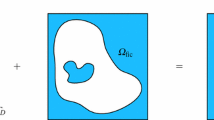Abstract
High fidelity finite element modeling of continuum mechanics problems often requires using all quadrilateral or all hexahedral meshes. The efficiency of such models is often dependent upon the ability to adapt a mesh to the physics of the phenomena. Adapting a mesh requires the ability to both refine and/or coarsen the mesh. The algorithms available to refine and coarsen triangular and tetrahedral meshes are very robust and efficient. However, the ability to locally and conformally refine or coarsen all quadrilateral and all hexahedral meshes presents many difficulties. Some research has been done on localized conformal refinement of quadrilateral and hexahedral meshes. However, little work has been done on localized conformal coarsening of quadrilateral and hexahedral meshes. A general method which provides both localized conformal coarsening and refinement for quadrilateral meshes is presented in this paper. This method is based on restructuring the mesh with simplex manipulations to the dual of the mesh. In addition, this method appears to be extensible to hexahedral meshes in three dimensions.




















Similar content being viewed by others
References
Carey G (1997) Computational grids: generation, adaptation, and solution strategies. Taylor & Francis, Washington
Plaza A, Carey GF (1996) About local refinement of tetrahedral grids based on bisection. Proceedings of the 5th international meshing roundtable. Sandia National Laboratories, Pittsburgh, pp 123–136
Plaza A, Rivara MC (2003) Mesh refinement based on the 8-tetrahedra longest-edge partition. Proceedings of the 12th international meshing roundtable. Sandia National Laboratories, Santa Fe, pp 67–78
De Cougny HL, Shephard MS (1999) Parallel refinement and coarsening of tetrahedral meshes. Int J Numer Methods Eng 46(7):1101–1125
Bey J (1995) Tetrahedral grid refinement. Computing 55(4):355–378
Grosso R, Lurig C, Ertl T (1997) The multilevel finite element method for adaptive mesh optimization and visualization of volume data. IEEE Vis 97:387–394
Molino N, Bridson R, Teran J, Fedkiw R (2003) A crystalline, red green strategy for meshing highly deformable objects with tetrahedra. Proceedings of the 12th international meshing roundtable, Sandia National Laboratories, Santa Fe, pp 103–114
Tchon K, Hirsch C, Schneiders R (1997) Octree based hexahedral mesh generation for viscous flow simulations. 13th AIAA computational fluid dynamics conference. AIAA-971980
Staten M (1996) Selective refinement of two and three-dimensional finite element meshes. M.S. Thesis, Brigham Young University, Provo
Staten M (1997) Local refinement of three-dimensional finite element meshes. Eng Comput 13:165–174
Marechal L (2001) A new approach to octree-based hexahedral meshing. Proceedings of the 10th interanational meshing roundtable. Sandia National Laboratories, Newport Beach, pp 209–221
Zhang Y, Bajaj C (2004) Adaptive and quality quadrilateral/hexahedral meshing from volumetric data. In: Proceedings of the 13th international meshing roundtable. Sandia National Laboratories, Williamsburg, pp 365–376
Schneiders R (2000) Octree-based hexahedral mesh generation. Int J Comput Geom Ap 10(4):383–398
Kwak DY, Im YT (2002) Remeshing for metal forming simulations—Part II: three-dimensional hexahedral mesh generation. Int J Numer Methods Eng 53(11):2501–2528
Li H, Cheng G (2000) New method for graded mesh generation of all hexahedral finite elements. Comput Struct 76(6):729–740
Tchon K, Dompierre J, Camarero R (2002) Conformal Refinement of all-quadrilateral and all-hexahedral meshes according to an anisotropic metric. Proceedings of the 11th international meshing roundtable. Sandia National Laboratories, Ithaca, pp 231–242
Tchon K, Dompierre J, Camarero R (2004) Automated refinement of conformal quadrilateral and hexahedral meshes. Int J Numer Methods Eng 59(12):1539–1562
Harris N (2004) Conformal refinement of all-hexahedral finite element meshes. M.S. Thesis, Brigham Young University, Provo
Borden M, Benzley S, Shepherd J (2002) Hexahedral sheet extraction. Proceedings of the 11th international meshing roundtable. Sandia National Laboratories, Ithaca, pp 147–152
Kallinderis Y, Kavouklis C (2005) A dynamic adaptation scheme for general 3-D hybrid meshes. Comp Method Appl Mech Eng 194:5019–5050
Benzley S, Harris N, Scott M, Borden M, Owen S. (2005) Conformal refinement and coarsening of unstructured hexahedral meshes. J Comput Inf Sci Eng 5(4):330–337
Tautges T, Blacker T, Mitchell S (1996) The whisker weaving algorithm: a connectivity-based method for all-hexahedral finite element meshes. Int J Numer Methods Eng 39(19): 3327–3349
Melander D, Tautges T, Benzley S (1997) Generation of multi-million element meshes for solid model-based geometries: the dicer algorithm. ASME Trends Unstructured Mesh Generation 220:131–135
Melander D (1997) Generation of multi-million element meshes for solid-based geometries: the dicer algorithm. M.S. Thesis, Brigham Young University, Provo
Staten M, Canann S (1997) Post refinement element shape improvement for quadrilateral meshes. ASME Trends Unstructured Mesh Generation 220:9–16
Murdoch P, Benzley S, Blacker T, Mitchell S (1997) The spatial twist continuum: a connectivity based method for representing all-hexahedral finite element meshes. Finite Elem Anal Des 28(2):137–149
Blacker T, The Cooper Tool (1996) Proceedings of the 5th international meshing roundtable. Sandia National Laboratories, Pittsburgh, pp 13–29
Staten M, Cannan S, Owen S (1998) BMSweep: locating interior nodes during sweeping. Proceedings of the 7th international meshing roundtable. Dearborn, pp 7–18
Author information
Authors and Affiliations
Corresponding author
Additional information
Sandia National Laboratories is a multiprogram laboratory operated by Sandia Corporation, a Lockheed Martin Company, for the United States Department of Energy under Contract DE-AC04-94AL85000.
Rights and permissions
About this article
Cite this article
Staten, M.L., Benzley, S. & Scott, M. A methodology for quadrilateral finite element mesh coarsening. Engineering with Computers 24, 241–251 (2008). https://doi.org/10.1007/s00366-008-0097-y
Received:
Accepted:
Published:
Issue Date:
DOI: https://doi.org/10.1007/s00366-008-0097-y




